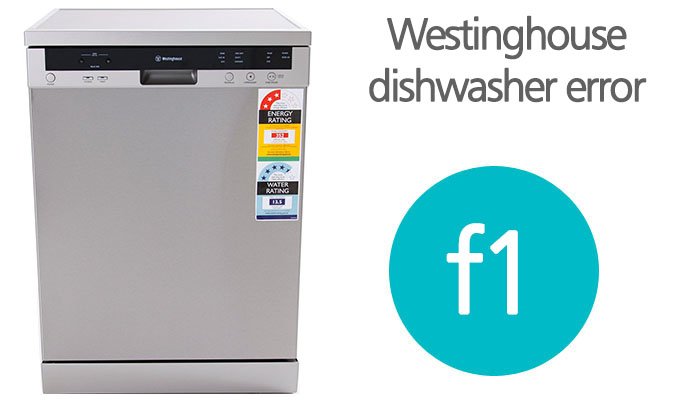
It’s undeniable that home appliances play a pivotal role in streamlining our domestic activities. Among these, the dishwasher is a major player, offering a blend of convenience and efficiency in managing kitchen hygiene. This discussion centers around the Westinghouse dishwasher, an acclaimed brand noted for its excellent reliability and longevity. However, as with any machine, even Westinghouse dishwashers can encounter certain glitches, notably the F1 error code.
The F1 error is a prevalent malfunction code that may surface on your Westinghouse dishwasher, posing potential interruptions to your appliance’s seamless operation. This might seem complex at first, but acquiring an understanding of its origins and potential remedies can empower you to troubleshoot, and possibly, rectify the issue independently.
Understanding the F1 Error Code
In the context of a Westinghouse dishwasher, the F1 error code signifies an issue with the water level, suggesting that there is an overabundance of water or an overflow in the lower compartment. If your dishwasher detects a rise in the water level or water presence in the catch pan, it communicates this concern by flashing the F1 error.
Root Causes of the F1 Error Code
The appearance of the F1 error code on your Westinghouse dishwasher can be triggered by several factors. The primary culprit is generally associated with the appliance’s float switch or flood switch. This switch is engineered to monitor water levels within the appliance. If the water level surpasses the designated limit or if the switch malfunctions, it triggers the F1 error code.
Moreover, an issue in the water inlet valve or a leaking component within the machine can also provoke the F1 error. Such issues lead to additional water trickling into the dishwasher, culminating in an overflow.
Troubleshooting Steps for the F1 Error Code
Addressing the F1 error might appear challenging, but a systematic methodology can demystify the process. Here are some steps to troubleshoot this anomaly:
- Power Disconnection: Initiate by disconnecting your dishwasher from its power source. This step is essential for safety, averting any potential electrical mishaps during the troubleshooting process.
- Dishwasher Inspection: Proceed to inspect the base of your dishwasher for any water traces. If water is found in the catch pan or underneath the dishwasher, it implies a possible leak.
- Float Switch Examination: Inspect the float switch to ascertain its correct functionality. If the switch is jammed or damaged, it could be erroneously signaling a high water level.
- Water Inlet Valve Assessment: A dysfunctional water inlet valve can permit excessive water into the appliance. Confirm that the valve is not damaged and is shutting appropriately after the dishwasher is filled.
Rectifying the F1 Error Code
If the F1 error code persists even after executing these troubleshooting measures, you may need to transition to resolving the issue:
- Water Evacuation: If water is present in the lower compartment or catch pan, remove it and ensure the area is dry. This can be achieved with a towel or a sponge.
- Float Switch Repair or Replacement: If the float switch is damaged or stuck, it may need to be cleaned, repaired, or substituted to address the issue.
- Leak Resolution: If a leak is detected within your dishwasher, it will necessitate a repair or the replacement of the faulty part.
- Water Inlet Valve Servicing: If the water inlet valve is defective, it needs to be serviced or replaced to maintain the appropriate water level in your dishwasher.
If you feel uneasy executing these steps independently, it’s highly advisable to seek assistance from a professional technician. They are equipped with the necessary expertise and tools to diagnose and fix your dishwasher’s F1 error code efficiently.
Mitigating the Occurrence of the F1 Error Code
While rectifying the F1 error is important, preventing it from occurring in the first place is equally significant. Regular maintenance is key. By routinely examining your dishwasher’s components and confirming they’re functioning optimally, you can stave off several potential issues, including the F1 error code.
Moreover, ensure that the dishwasher’s drain hose is installed correctly and is not clogged or twisted, and that the filter is free from debris. Avoid overusing dishwasher detergent as this could lead to foam overflow and potentially trigger the float switch.
Lastly, make sure that the water inlet valve is operating correctly. An inlet valve on the verge of failing can allow too much water into the appliance, so replace it before it results in an overflow.
Conclusion
Experiencing the F1 error code on your Westinghouse dishwasher can be an inconvenient ordeal. However, with a comprehensive understanding of what this error represents, its underlying causes, and the steps required to troubleshoot and resolve it, you can potentially conserve time, money, and prolong your dishwasher’s lifespan.
Bear in mind that while some basic troubleshooting and minor repairs can be conducted independently, you should always engage a professional when dealing with complex issues or if you’re uncomfortable performing the tasks. This not only ensures your appliance is handled correctly but also safeguards your safety. After all, your dishwasher is a valuable asset that deserves meticulous care to continue providing its invaluable benefits.
